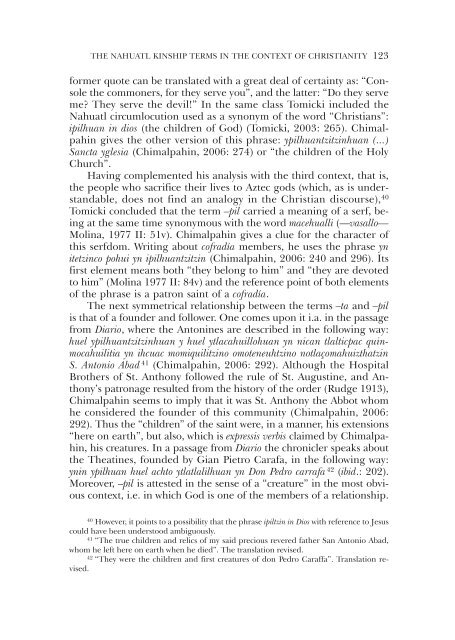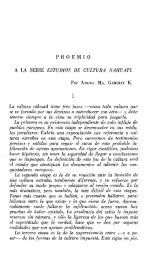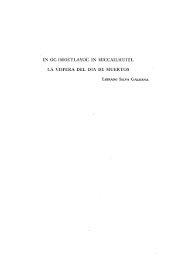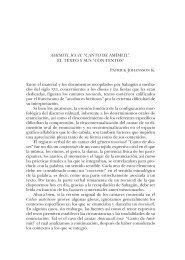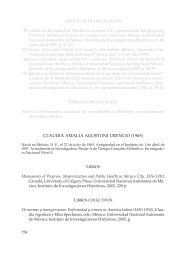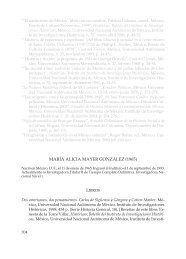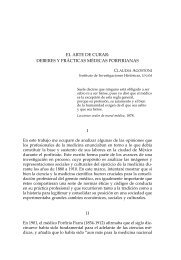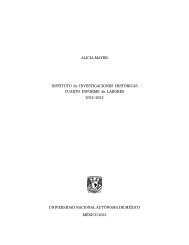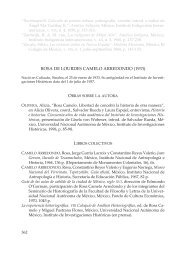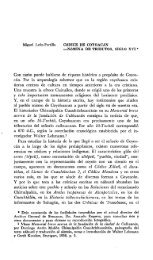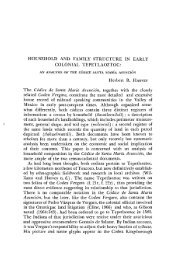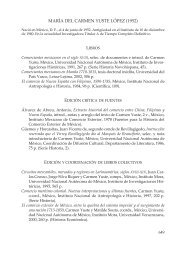“HOLY FAMILY”. THE NAHUATL KINSHIP TERMS IN THE ...
“HOLY FAMILY”. THE NAHUATL KINSHIP TERMS IN THE ...
“HOLY FAMILY”. THE NAHUATL KINSHIP TERMS IN THE ...
You also want an ePaper? Increase the reach of your titles
YUMPU automatically turns print PDFs into web optimized ePapers that Google loves.
The Nahuatl kinship terms in the context of Christianity 123<br />
former quote can be translated with a great deal of certainty as: “Console<br />
the commoners, for they serve you”, and the latter: “Do they serve<br />
me? They serve the devil!” In the same class Tomicki included the<br />
Nahuatl circumlocution used as a synonym of the word “Christians”:<br />
ipilhuan in dios (the children of God) (Tomicki, 2003: 265). Chimalpahin<br />
gives the other version of this phrase: ypilhuantzitzinhuan (...)<br />
Sancta yglesia (Chimalpahin, 2006: 274) or “the children of the Holy<br />
Church”.<br />
Having complemented his analysis with the third context, that is,<br />
the people who sacrifice their lives to Aztec gods (which, as is understandable,<br />
does not find an analogy in the Christian discourse), 40<br />
Tomicki concluded that the term –pil carried a meaning of a serf, being<br />
at the same time synonymous with the word macehualli (—vasallo—<br />
Molina, 1977 II: 51v). Chimalpahin gives a clue for the character of<br />
this serfdom. Writing about cofradía members, he uses the phrase yn<br />
itetzinco pohui yn ipilhuantzitzin (Chimalpahin, 2006: 240 and 296). Its<br />
first element means both “they belong to him” and “they are devoted<br />
to him” (Molina 1977 II: 84v) and the reference point of both elements<br />
of the phrase is a patron saint of a cofradía.<br />
The next symmetrical relationship between the terms –ta and –pil<br />
is that of a founder and follower. One comes upon it i.a. in the passage<br />
from Diario, where the Antonines are described in the following way:<br />
huel ypilhuantzitzinhuan y huel ytlacahuillohuan yn nican tlalticpac quinmocahuilitia<br />
yn ihcuac momiquilitzino omoteneuhtzino notlaçomahuizthatzin<br />
S. Antonio Abad 41 (Chimalpahin, 2006: 292). Although the Hospital<br />
Brothers of St. Anthony followed the rule of St. Augustine, and Anthony’s<br />
patronage resulted from the history of the order (Rudge 1913),<br />
Chimalpahin seems to imply that it was St. Anthony the Abbot whom<br />
he considered the founder of this community (Chimalpahin, 2006:<br />
292). Thus the “children” of the saint were, in a manner, his extensions<br />
“here on earth”, but also, which is expressis verbis claimed by Chimalpahin,<br />
his creatures. In a passage from Diario the chronicler speaks about<br />
the Theatines, founded by Gian Pietro Carafa, in the following way:<br />
ynin ypilhuan huel achto ytlatlalilhuan yn Don Pedro carrafa 42 (ibid.: 202).<br />
Moreover, –pil is attested in the sense of a “creature” in the most obvious<br />
context, i.e. in which God is one of the members of a relationship.<br />
40<br />
However, it points to a possibility that the phrase ipiltzin in Dios with reference to Jesus<br />
could have been understood ambiguously.<br />
41<br />
“The true children and relics of my said precious revered father San Antonio Abad,<br />
whom he left here on earth when he died”. The translation revised.<br />
42<br />
“They were the children and first creatures of don Pedro Caraffa”. Translation revised.


